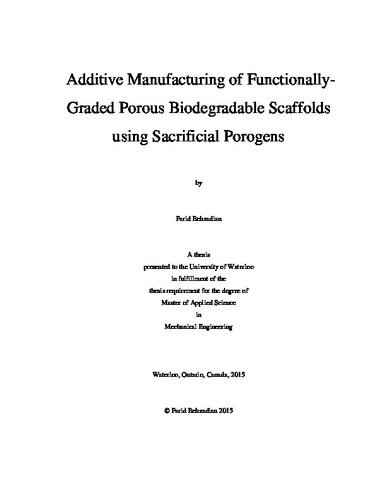| dc.description.abstract | The focus of this dissertation is on the additive manufacturing (AM) of a porous biodegradable scaffold using a fine Calcium Polyphosphate (CPP) powder, with the aid of sacrificial porogens. CPP is a member of Calcium Phosphate (CaP) bioceramic family which has shown great potential in bone tissue engineering over the past years. AM processes are fairly new technologies that have been involve in many different industries and applications, including bone tissue engineering. Not too long ago, CPP was investigated using a powder based 3D printing technique, which is an AM process, and it was revealed that this new manufacturing process offers a great potential in improving previous finding made by traditional fabrication techniques. Over the past few years there have been many different studies on 3D printing CPP substrate, but almost all of those studies were based on using a large particle CPP powder.
In this study, the fabrication of CPP structures was based on using a fine CPP powder with a particle size of < 75µm. 3D printing fine dry powder has one main challenge which is flowability of the powder, and in this study a new solution has been suggested to improve the flow behavior of the fine CPP powder. Polyvinyl Alcohol (PVA) powder with a particle size of 75-106 µm was chosen as the large sacrificial particles so called porogens, to be mixed with fine CPP powder to improve the flowability. In order to improve the flow behavior of the powder in the AM process, various percentages of porogens were mixed with the fine CPP powder to fine the appropriate dosage. Furthermore, there were two different liquid binders tested in the AM process. After CPP parts were fabricated, all specimens were measured in dimensions before and after the sintering. The dimensional measurements were used to determine the shrinkage percentage. Then the sintered parts had to be tested one by one through Archimedes method to find the porosity percentage corresponding to each individual sample. Following that, uniaxial compression test was applied to evaluate the mechanical strength of each specimen. In order to look at the micro structures of samples and making sure the particle have formed good bonding/sinter necks, random specimens were chosen to me examined using Scanning Electron Microscopy (SEM). Moreover, different powders were sent to an external facility to be tested for the flow behavior and the average particle size by using a rheometer and a laser diffraction method, respectively.
The results were analyzed for different categories based on the pre mixed porogens percentage. It was proven that adding porogens definitely improves the flowability of the fine powder; it also increases the shrinkage percentage of samples. Then the results were compared with previous findings that were based on using a large particle CPP powder; it was shown that some of those previous finding obtain by 3D printing large particle CPP powder, can be achieved by doing the same using the fine CPP powder. Furthermore, a new higher compressive strength was reported in this study that was not achieved in previous reports which was based on the large particle CPP powder. | en |

